The 2019 Trade Deadline has come and gone, and what started out as a slow-developing deadline day ended with a flurry of trades. Within that flurry of moves were two trades that involved the Nashville Predators as they acquired Mikael Granlund and Wayne Simmonds. General manager David Poile, like the general managers of other contenders, made moves to bolster his roster in preparation for what will hopefully be a deep playoff run.
Related: 2019 Trade Deadline Trade Tracker
But the Predators’ 2019 Trade Deadline involved more than adding Granlund and Simmonds as Poile acquired Brian Boyle and Cody McLeod in the weeks leading up to the deadline. This article is a recap of all four trades and what I think each player can bring to the team.
Acquiring Boyle from the Devils
On Feb. 6, the Predators acquired Boyle from the New Jersey Devils in exchange for a 2019 second-round pick. The 34-year-old center, and former first-round pick of the Los Angeles Kings, had 13 goals and six assists, including six goals and two assists on the man advantage, in 47 games with the Devils prior to the trade. Since joining the Predators, Boyle has fit in quite well with two goals, both at even strength, in 10 games.
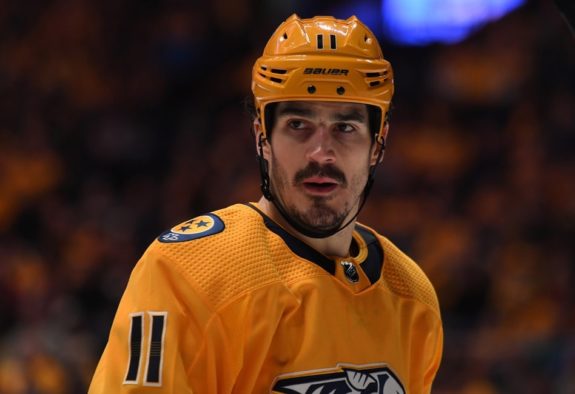
He has averaged 14:11 of ice time per-game and is winning 53.8 percent of faceoffs with Nashville. Although he hasn’t had any points on the power play, his ability to generate screens and create havoc as a net-front presence has been impactful as the Predators have been more of a threat to score on the power play since he joined the team than they had all season. For what it’s worth, he has also been unafraid to mix it up with opponents, having fought Dion Phaneuf in a game against the Kings. Prior to the trade, the Predators had few players who were physical while still productive offensively.
Related: Predators Getting Boyle Makes Perfect Sense
Adding Physical Presence with McLeod
Also on Feb. 6, Poile acquired McLeod from the New York Rangers and gave up a 2020 seventh-round pick in return. Poile traded for McLeod in response to Austin Watson’s indefinite suspension and Zac Rinaldo’s season-ending injury. The Predators were also familiar with McLeod, having employed him for parts of the 2016-17 and 2017-18 seasons before the Rangers claimed him off waivers on Jan. 25, 2018.
In 31 games with the Rangers this season, he had one goal, his only point, and 60 penalty minutes, including six fighting majors. Since joining the Predators, he has often been a healthy scratch and has appeared in five games. He has gone pointless and has one fighting major.
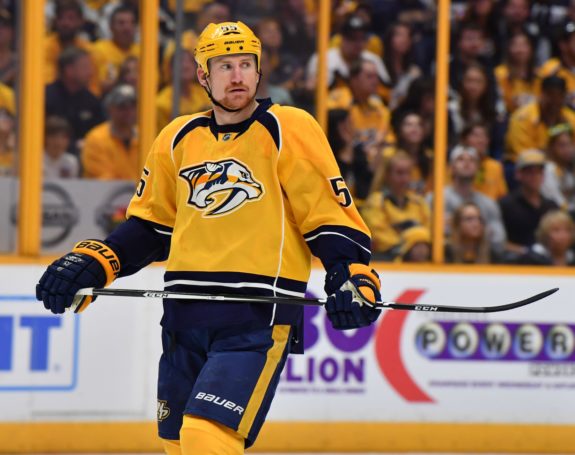
Seeing as how I’m not a fan of fighting in hockey and find enforcers pointless if they can’t bring anything offensively, I don’t understand why Poile acquired him. McLeod may have 72 career goals, but he hasn’t surpassed the double-digit mark in a decade. Luckily, reacquiring him only meant parting with a seventh-round pick, and his lack of production shouldn’t hurt the Predators much as he’ll likely be relegated to the press box most games when the roster is fully intact.
Swapping Fiala for Granlund
In what can only be described as one of the more shocking moves of deadline day, the Predators acquired Granlund from the Minnesota Wild and gave up Kevin Fiala to get the deal done. Sure, Fiala’s name had come up as a potential return in a trade for Matt Duchene or Mark Stone, something I had suggested, but the Predators were never connected to Granlund, at least not publicly.
In a swap of former first-round draft picks, I feel this trade is best described as a potential-for-proven move, with both players looking to benefit from a change of scenery. Granlund has a lengthy track record as a productive NHL forward while Fiala likely has untapped potential remaining. The Wild drafted Granlund ninth overall in the 2010 Draft after a successful career in his native Finland. He spent the next two seasons in Finland’s Liiga before making his NHL debut in 2012-13.

He became a regular NHL-er in 2013-14 and has since become one of the league’s better two-way forwards. He has surpassed the 40-point mark each of the past four seasons, including 2018-19, and in five of his six full NHL seasons. He’s also reached the 20-goal mark the past two seasons, and has eclipsed the 60-point mark in both, as well. This season, in 63 games, he has 15 goals and 49 points, which would put him fourth and third on the Predators, respectively, despite those totals being below his rates from 2016-17 and 2017-18.
He has had strong five-on-five possession metrics throughout his career, and that is especially true this season with at least a 55 percent control of goals, scoring chances and high-danger chances when he’s on the ice. He’s also a possession-driver for his line and played a great deal this season with Zach Parise. In 296 shared five-on-five minutes, Granlund improved Parise’s metrics in all areas. He also took Minnesota’s offense from a minus-six percent threat without him on the ice to a plus-12 percent threat with him deployed.
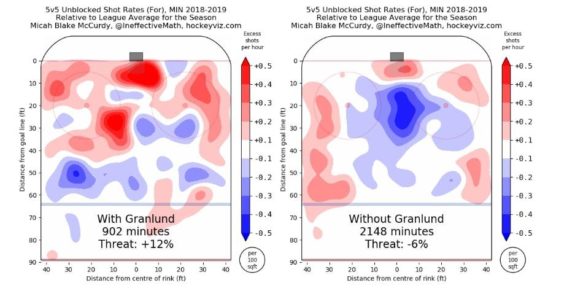
It’s likely Granlund will play on Nashville’s second line with Kyle Turris and one of Craig Smith, Calle Järnkrok and Wayne Simmonds, and should succeed in doing so. He’s a smaller forward at 5-foot-10 and 185 pounds, but has excellent hands and skates well. That type of player works well with the Predators – see Viktor Arvidsson and Järnkrok as examples.
Granlund also has that strong two-way style of play and good vision that so many Finns have. He plays in all situations, averaging 2:46 per-game on the power play and 46 seconds per-game shorthanded this season. He holds his own in the faceoff circle, but isn’t great, with a 45 percent success rate this season. He also rarely takes penalties with only 20 penalty minutes this season.
But, make no mistake, parting with Fiala wasn’t easy. The Predators used the 2014 11th-overall pick on him and he had been developing into a productive player with lots of upside. Last season, he set career highs with 23 goals and 48 points in 80 games and there was excitement over what this season could bring. However, although he’s accumulated assists (22 in 64 games), his 10 goals show he’s not scoring enough. At 22, he’s still young, but wasn’t developing the way the Predators wanted.

A quick comparison of Fiala and Granlund shows two similar players. Fiala is younger than Granlund, who turns 27 today. Fiala likely also possesses the higher offensive upside given his shot and playmaking abilities. Meanwhile, Granlund is the better player away from the puck and is more well-rounded as Fiala doesn’t kill penalties. Contractually, Granlund has one more season left with a $5.75 million cap hit while Fiala’s entry-level contract expires at season’s end.
Bolstering Power Play with Simmonds
In the Predators’ last move on deadline day, they acquired Simmonds from the Philadelphia Flyers in exchange for Ryan Hartman and a conditional 2020 fourth-round pick. The pick becomes a third-round selection if the Predators win a round in the 2019 Playoffs.
The Predators acquiring Simmonds was a surprise to no one as the two were connected for sometime. It’s obvious what he’ll bring to Nashville: he’s a power forward who thrives in a net-front role, especially on the power play. He has 16 goals and 11 assists, including five goals and three assists on the man advantage, in 62 games this season. That’s a steep decline from the consecutive 30-goal seasons he had in 2015-16 and 2016-17, or even the 24 goals he netted last season. He also isn’t the two-way player nor the possession driver he was in seasons past.
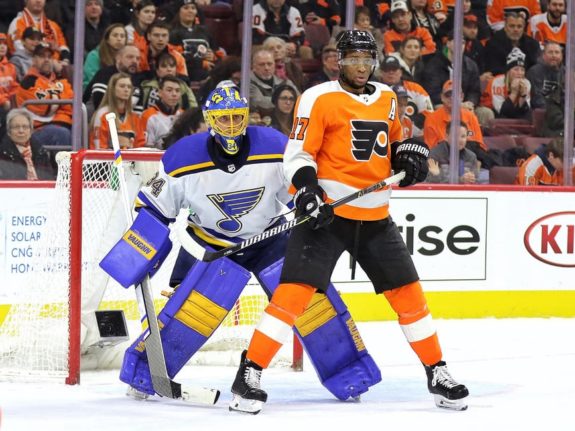
That being said, he is still a threat offensively and knows how to score goals. He goes to the front of the net, generates screens, creates room for he and his teammates, gets tips on pucks and capitalizes on rebounds. He should boost a power play that ranks last in the league. Plus, there’s the hope that Simmonds can regain his scoring touch playing for Peter Laviolette who was his first coach in Philadelphia. It was under Laviolette’s leadership that Simmonds had his first 20-goal and 40-point season in 2011-12.
When I wrote my trade deadline targets piece on the Flyers, I didn’t think it was a good idea to pursue Simmonds. But that was based on them giving up a first-round pick, top prospect or Fiala for Simmonds when he is a free agent at season’s end and therefore a likely playoff rental. However, because Poile only gave up Hartman and a mid-round draft pick, it’s a good trade on the surface.
The Predators acquired Hartman at the 2018 Trade Deadline when they gave up two draft picks, including a first-rounder, and a prospect for him. That trade was widely viewed as an overpay for a third-line forward who hasn’t performed that well with 10 goals and 20 points in 64 games this season. While this trade doesn’t make the Hartman acquisition any better, it does close the book on his tenure in Nashville and results in something positive.
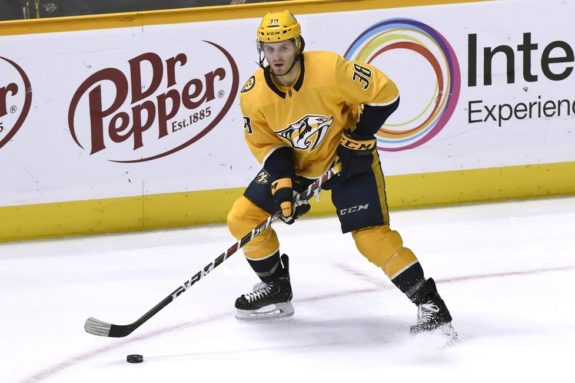
Trades Results Will Matter Most
Ultimately, the most important aspect of these four deals will be what they result in. We have a pretty good idea of the contributions of Boyle and McLeod. Boyle has been a positive impact player so far while McLeod is who he is, an enforcer who brings little production. What impacts Granlund and Simmonds have on the Predators the rest of the season will determine the values of those trades.
We’ll know pretty quickly what Simmonds brings as he’s expected to be in the lineup tonight as the Predators take on the St. Louis Blues. Granlund may take a few extra days as he and his fiance welcomed their first child and Poile is giving him family time before joining the team. After both players have been Predators for a week or so, I plan on readdressing the trades based on how well they’ve fit into the lineup. But, for now, both players seem like quality pickups with a fair price being paid for each.
*All stats and information came from Hockey-Reference, Natural Stat Trick and HockeyViz